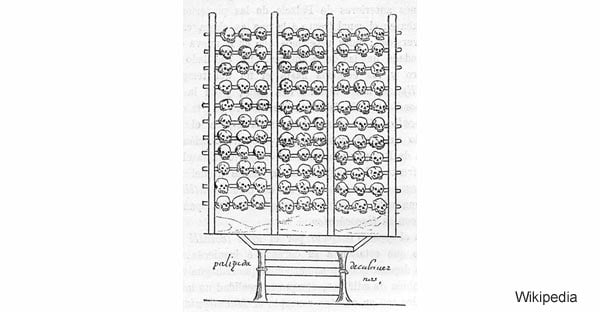Archaeologists have made an announcement about an unusual Aztec sacrificial offering, which was found back in 2009 but kept under wraps until now. The discovery consists of a dog’s skull with holes that indicate it was displayed on a ritual skull rack normally reserved for human sacrifice victims. The skulls of one female and two males with the same perforations were also found nearby, as well as about 100 burials, mostly of children. The excavations were carried out as part of a 25 kilometre expansion of the city’s subway station.

The find dates to between 1350 and 1521 and is the first time a dog’s skull has been found along with a skull rack, according to Mexico’s National Institute of Anthropology and History.
Ritual skull racks, known as tzompantli (as shown in the picture opposite), were used to mount the heads of sacrifice victims, usually captured warriors from rival groups, and place them on public display. Few of them have actually been excavated.
“What little information we have on the use of skull racks indicates that they were the resting place for the heads of war captives, and females generally were not taken in war,” said University of Florida archaeologist Susan Gillespie. This makes the discovery of the female skull quite unusual. But most mysterious of all, is the dog’s skull.

“We know that during the conquest some horse skulls were placed on this typee of structure, but not dogs,” said institute archaeologist Maria de Jesus Sanchez, referring to an account documented by the Spanish conquerors who found the remains of captured colleagues as well as their horses displayed on a rack.
One possible explanation might have been dogs’ ritual importance in death or burial rites. According to some pre-Hispanic beliefs, a dog accompanied his owner in the underworld. Among the Aztecs, the god Xolotl was the canine companion of the Sun, following its path through both the sky and the underworld. Xolotl’s strong connection with the underworld, death and the dead is demonstrated by the symbols he bore. In the Codex Borbonicus, Xolotl is pictured with a knife in his mouth, a symbol of death, and has black wavy hair like the hair worn by the gods of death.
“Perhaps there are dogs associated with these altars in other sites and we don’t know it,” de Jesus said.